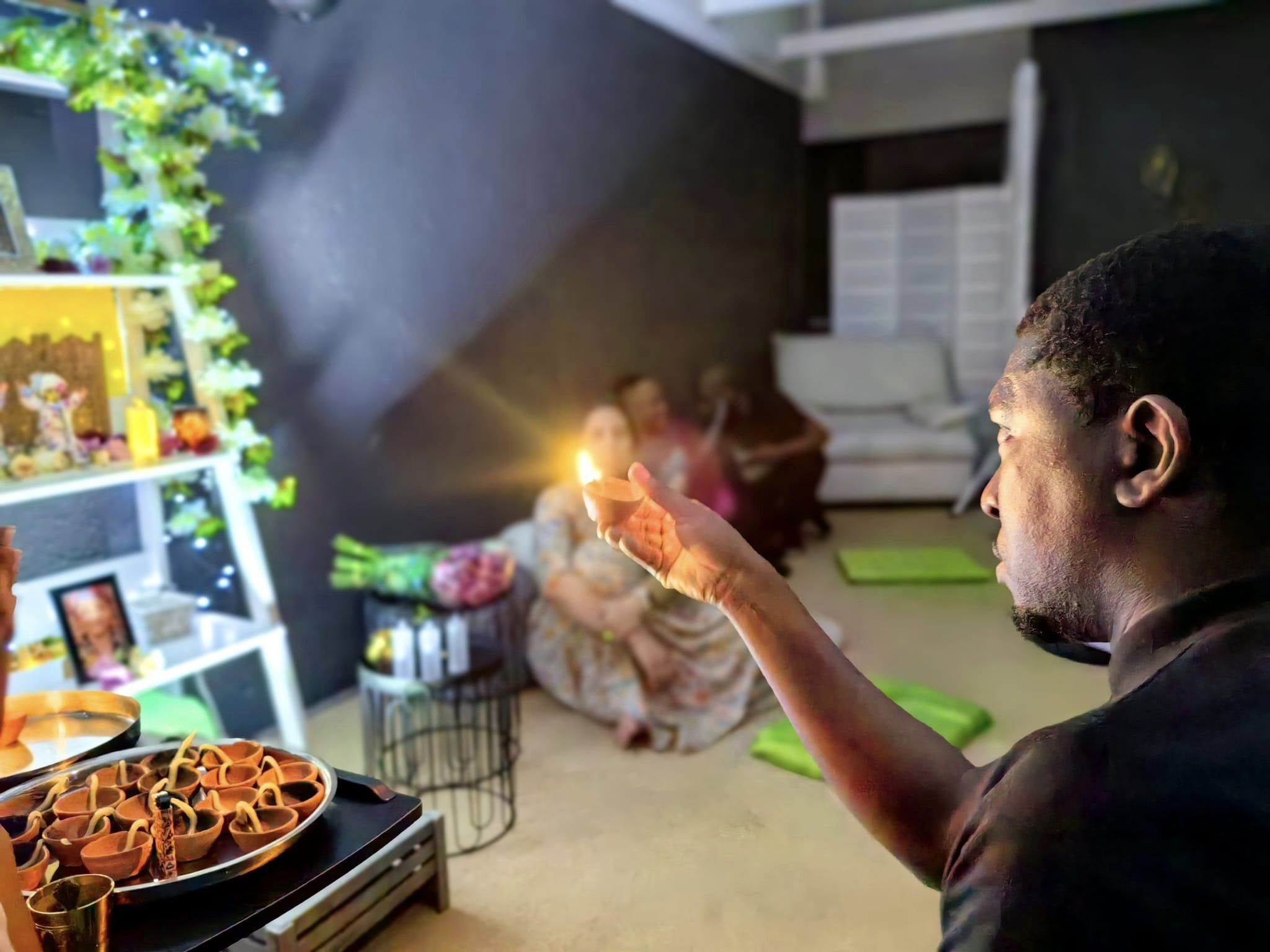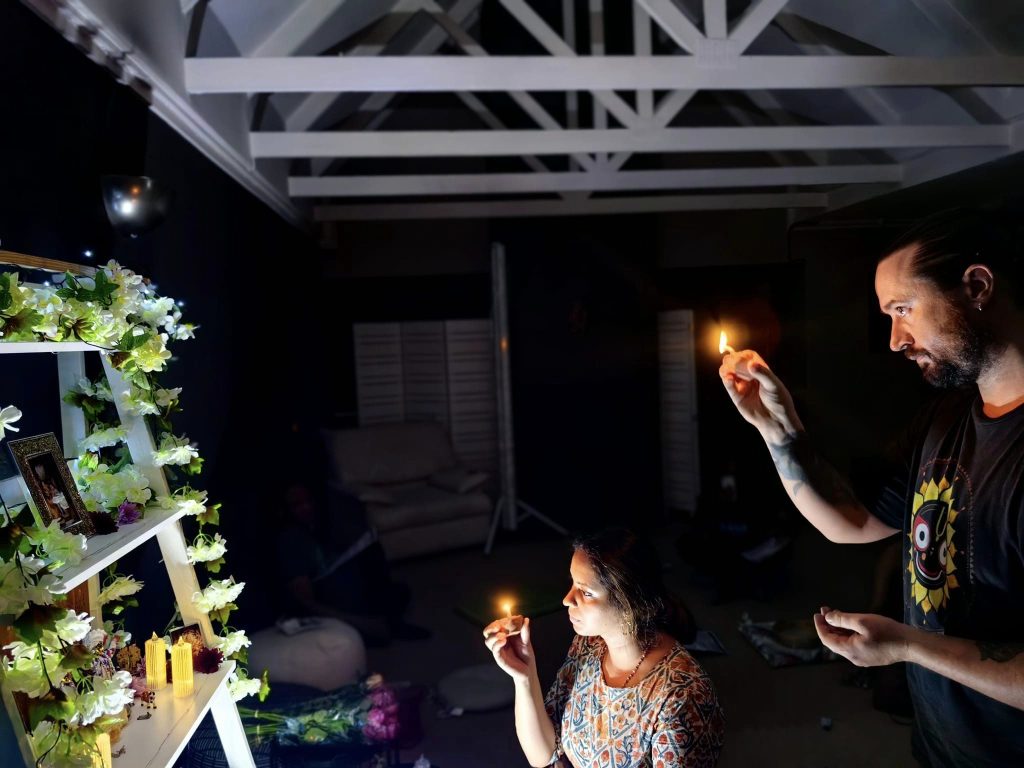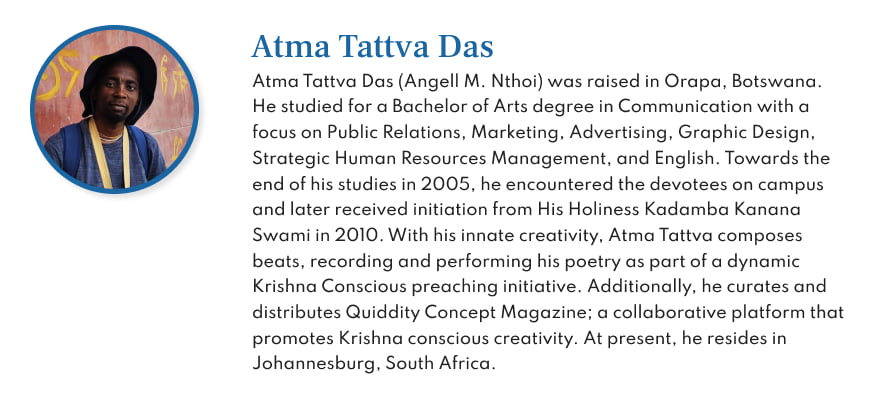The Sacred Observance of Kartik: A Month of Deep Devotion and Comedic Vows
By Atma Tattva Das, ISKCON News Staff Writer | Oct 13, 2024

University student learning how to offer a lamp WuSA House in South Africa.
As the month of Kartika approaches, devotees of Krishna around the world are gearing up for one of the most spiritually potent times in the Vaishnava calendar. Taking place during October and November, this month is revered as the holiest of the year, and it offers a unique opportunity for spiritual advancement. From candlelit offerings to vows of austerity, Kartika is a time when devotees focus their hearts on Lord Krishna, specifically in His childhood form as Damodara, who was once famously bound with rope by His mother, Yashoda, to curb His mischievous activities.
The significance of Kartika lies in its connection to Chaturmasya, the four months marking the rainy and autumn seasons in India. Traditionally, during this time, itinerant priests and preachers would refrain from traveling, choosing instead to deepen their spiritual practices. Kartika, the last of these four months, is when devotees make additional vows, perform extra devotional activities, and worship Krishna with greater intensity.
One of the highlights of Kartika is the Damodarastakam prayer, which is sung daily by devotees as they offer a candle or ghee lamp to Krishna. This offering symbolizes the light of devotion, illuminating the dark corners of the soul. Families, young and old, gather to perform this simple yet profound ritual, creating a serene atmosphere of reverence and love.
Devotees also observe major festivals like Diwali, the Festival of Lights, which celebrates Lord Rama’s return to Ayodhya, and Govardhan Puja, commemorating Krishna’s lifting of Govardhan Hill to protect the residents of Vrindavan. These festivals, intertwined with the Kartika celebrations, add layers of joy, tradition, and worship.

Students learning about Kartika at WuSA House.
But what truly makes Kartika special is its focus on voluntary vows. As Sacinandana Swami once aptly put it, “During the month of Kartika… devotees of Lord Krishna are advised to increase their concentration on His worship by dedicating their daily devotional hearing and chanting to Srimati Radharani, His eternal consort.” These vows, offered in the mood of deep devotion, range from giving up certain foods to intensifying one’s practice of chanting the Hare Krishna mantra. This invocation calls upon both Radha and Krishna to seek their engagement in service.
While some vows are born of a heartfelt desire for spiritual progress, others, over the years, have taken a more…unconventional turn. In the spirit of Kartika, we can’t help but chuckle at some of the most bizarre vows devotees have made, reminding us that devotion, even in its quirkiest forms, is still devotion. From giving up their favorite pillow to vowing not to speak more than 500 words a day (a nightmare for anyone who enjoys chatting), devotees have shown that their creativity knows no bounds.

Offering lamps during Kartika.
Let’s close with Ten Fun Facts About Kartika that might surprise even seasoned observers:
1. Damodara’s Ropes of Love: The name “Damodara” comes from “dama,” meaning rope, and “udara,” meaning belly—highlighting the divine play where His mother’s love binds Krishna.
2. The Elephant Blessing: During Kartika, any good deed is said to be rewarded a thousandfold—imagine receiving the blessings of a spiritually charged elephant!
3. Lamp Offering Rewards: Offering a lamp to Krishna during this month is said to eliminate sins from a hundred lifetimes. No pressure!
4. Yogurt’s Special Status: Yogurt plays a key role in Kartika, as it was with a pot of yogurt that Yashoda chased Krishna before binding Him.
5. Vow Variety: Devotees might give up everything from sweets to speaking at work meetings, which can create interesting office dynamics.
6. Ghee Lamps vs. Oil Lamps: Ghee lamps are preferred because ghee represents purity and is believed to carry the offering directly to the divine.
7. Diwali’s Spiritual Significance: While widely celebrated as the occasion of Lord Rama’s return, Diwali also marks the time when Krishna defeated the demon Narakasura, another reason to light those lamps!
8. Govardhan Hill’s Eco Message: Krishna’s lifting of Govardhan Hill is seen as a divine message on environmental consciousness and caring for nature.
9. The Ultimate Gift: Performing even a small act of devotion during Kartika is believed to lead to liberation from the cycle of birth and death.
10. Comedic Vows Galore: From vowing not to drink orange juice for a month to promising to walk only backward in temple hallways, Kartika inspires some hilariously inventive acts of devotion.
In the end, Kartika is a time of profound spiritual opportunity and joy, a month where devotees can intensify their connection with Krishna while laughing at the lighter side of their heartfelt vows. Whether offering lamps or giving up candy, the essence of Kartika lies in its sincere expression of love for the Supreme, even when wrapped in a quirky vow never to eat a banana again.
Opinions expressed do not necessarily reflect the opinions and beliefs of ISKCON or ISKCON News.
















